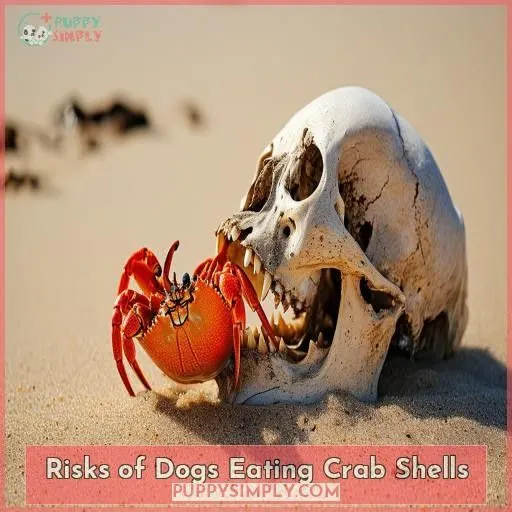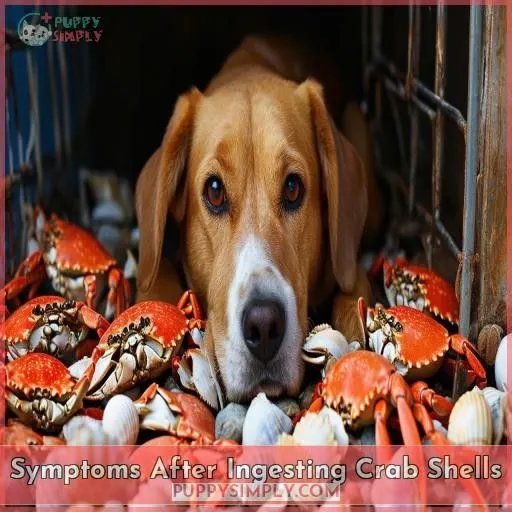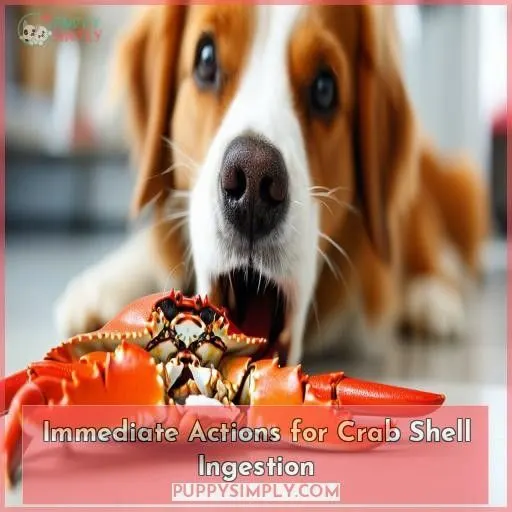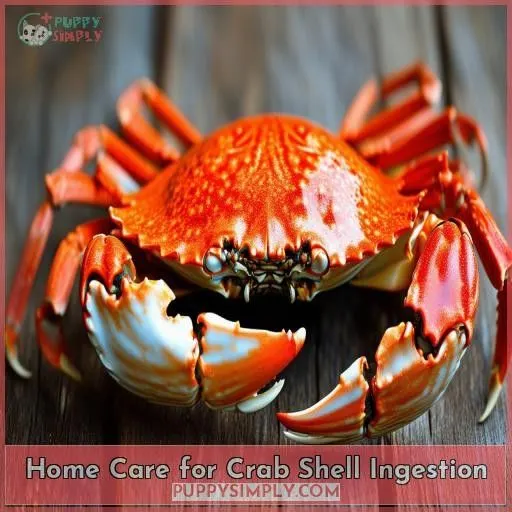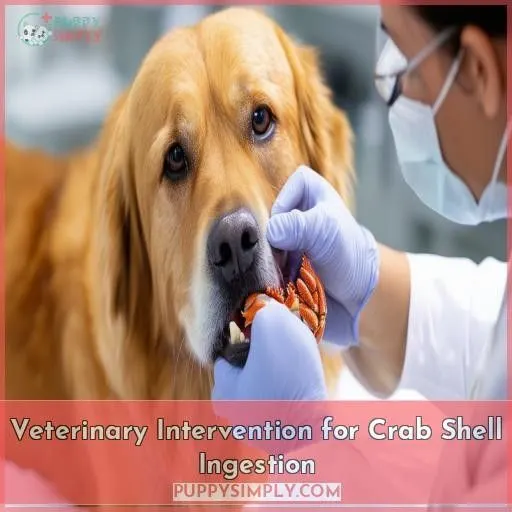This site is supported by our readers. We may earn a commission, at no cost to you, if you purchase through links.
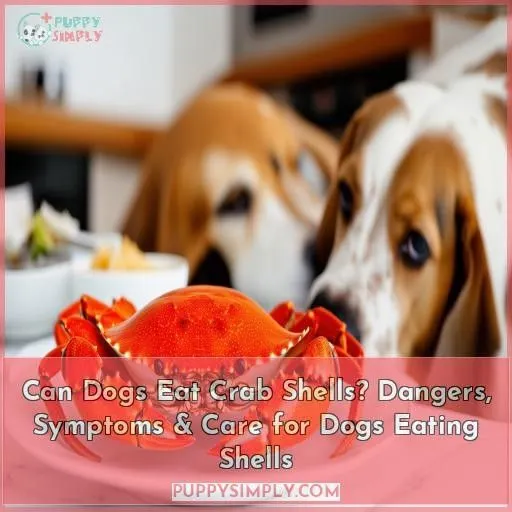
Imagine the heartbreak of your pup suffering from vomiting, bleeding, and excruciating pain – all because of a crunchy snack. Don’t risk it!
If your furry friend has ingested shells, get to the vet immediately for diagnostic tests and potential surgery. With proper care, like a bland diet and monitoring for complications, your canine companion can recover without lasting harm.
But the lesson is clear: keep those crab shells far away to avoid a nightmare situation.
Table Of Contents
Key Takeaways
- Crab shells are a crunchy catastrophe waiting to happen for our furry friends. Those razor-sharp edges can wreak havoc on their delicate guts, causing nasty lacerations, blockages, and a whole world of hurt that no dog parent wants to witness.
- If your pup has taken a bite of the forbidden fruit (or shell, in this case), keep a watchful eye for telltale signs of trouble – vomiting, lethargy, or a tummy that’s tenser than a coiled spring. Trust your gut instinct and don’t hesitate to seek veterinary guidance, because dealing with a blockage is no walk in the park.
- In the aftermath of a shell-ingestion incident, your furry pal will need some serious TLC. A bland, fiber-rich diet can help those pesky fragments make their exit safely, but be prepared for frequent pit stops – and maybe a few messes along the way. Hey, that’s the price we pay for their unconditional love, right?
- At the end of the day, an ounce of prevention is worth a pound of cure. Stash those crab shells securely, out of reach of curious snouts and wagging tails. Because as tempting as they might seem, they’re a nightmare waiting to happen – and our furry besties deserve only the best care and snacks we can provide.
Can Dogs Eat Crab Shells?
No, dogs shouldn’t eat crab shells. Crab shells can cause gastrointestinal lacerations or intestinal blockages in dogs, leading to serious health complications.
Risks of Dogs Eating Crab Shells
Allowing your dog to ingest crab shells can lead to serious gastrointestinal issues. The sharp edges of the shells pose a risk of lacerating the digestive tract, while the shells themselves can cause intestinal blockages if swallowed whole.
Gastrointestinal Lacerations
Those sharp crab shell edges pack a punch – one wrong move, and you’re risking:
- Nasty lacerations along Fido’s gastrointestinal tract
- Vomiting, bleeding, and unimaginable pain
- A costly emergency vet visit
- Surgery to remove the shell fragments
- Heartbreak over your fur-baby’s suffering
Proper shell disposal and pet-proofing are musts for avoiding this preventable nightmare. Stay vigilant – your pup’s counting on you!
Intestinal Blockages
Let’s not put your furry friend’s health at risk. Besides causing nasty cuts, those crab shells could get lodged in their intestines—a dangerous obstruction that can wreak havoc, leading to vomiting, constipation, or worse. It’s a pet parent’s nightmare, trust me:
| Outcome | Mild | Moderate | Severe |
|---|---|---|---|
| Discomfort | Upset Tummy | Intestinal Blockage | Surgery Required |
Symptoms After Ingesting Crab Shells
If your dog has ingested crab shells, you may notice signs of nausea and vomiting, as the sharp edges can irritate the gastrointestinal tract. Vomiting can quickly lead to dehydration, so it’s imperative to monitor your dog closely and take appropriate actions.
Nausea and Vomiting
You’ll know something’s wrong when your pup starts vomiting after eating crab shells. It’s a tell-tale sign of:
- Nausea from the sharp edges
- An upset stomach
- Potential blockages brewing
- The need for a vet visit ASAP
Don’t brush it off – vomiting signals your dog’s body rejecting those pesky shells. Time for some TLC and a bland diet to help their tummy recover.
Dehydration
If your dog continues vomiting after ingesting crab shells, dehydration becomes a serious concern. Vomiting leads to fluid and electrolyte loss, which can quickly cause weakness and diarrhea. Severe dehydration may even progress to kidney failure or pancreatitis if left untreated. Seek veterinary care promptly to prevent these dangerous complications.
Immediate Actions for Crab Shell Ingestion
If your dog has ingested crab shells, prevent them from eating grass, which can worsen nausea and vomiting. Seek prompt veterinary attention and consider giving an antacid like Pepcid-ac or Prilosec to reduce stomach acid irritation.
Preventing Grass Eating
You’ll want to prevent your dog from eating grass, as this can lead to further nausea and vomiting. Here are some tips:
- Restrict access to grassy areas
- Offer alternatives like chew toys or treats
- Use a basket muzzle when outside
- Distract with games or training
- Provide enrichment to curb the behavior
Grass eating is often a sign of an underlying issue, so monitoring and addressing the root cause is essential.
Seeking Veterinary Care
You must seek veterinary care immediately if your dog ingests crab shells. The risks of delayed treatment are severe, potentially leading to intestinal obstructions, perforations, and life-threatening complications. Your vet will likely need to perform diagnostic tests and may even recommend surgery to remove shell fragments. Closely monitoring your pup for worsening symptoms like vomiting, lethargy, or abdominal pain is imperative.
| Risk | Potential Complication |
|---|---|
| Gastrointestinal Laceration | Bleeding, Infection |
| Intestinal Blockage | Rupture, Peritonitis |
| Delayed Treatment | Long-term Damage |
Administering Antacids
You’ll want to give your pup an antacid like Pepcid-ac or Prilosec. These over-the-counter meds reduce stomach acid, which can irritate their system after ingesting sharp crab shells. Follow dosage instructions carefully. Antacids can ease nausea and vomiting, giving their digestive tract a break while the shells pass.
Home Care for Crab Shell Ingestion
If your dog has ingested crab shells, it’s essential to feed a bland diet with added fiber, like boiled chicken or hamburger meat mixed with white rice and pumpkin. Offer small, frequent meals and monitor closely for signs of complications such as continued vomiting, abdominal pain, fever, or lethargy.
Bland Diet With Fiber
If your dog ingests crab shells, you’ll want to feed a bland, high-fiber diet to help move the fragments through their system safely. Boiled chicken or hamburger with white rice and pumpkin puree provides essential nutrients while the fiber aids digestion. Offer small portions to avoid overwhelming their sensitive stomach.
Small, Frequent Meals
In addition to feeding a high-fiber, bland diet, you’ll want to space out meals into smaller portions throughout the day. This helps prevent dehydration and eases digestion while your pup recovers. Some tips:
- Feed 4-6 mini-meals per day
- Use shallow bowls for easy eating
- Watch for signs of fullness
- Slowly [CHANGE] back to their regular diet
Frequent, gradual meals aid healing and prevent discomfort. Just be patient—recovery takes time.
Monitoring for Complications
Keep a close eye on your pup for signs of complications like lethargy, tense belly, fever, or continued vomiting. Monitor their stools for any shell fragments that may have passed. If fragments haven’t been expelled within two days or concerning symptoms arise, don’t hesitate – seek veterinary care promptly.
Veterinary Intervention for Crab Shell Ingestion
If crab shell fragments aren’t passing through your dog’s digestive system within two days after ingestion, or if your dog shows signs of an intestinal blockage like a tense abdomen, persistent vomiting, lethargy, or fever, you should seek veterinary care immediately.
Your veterinarian may recommend medications to help move the fragments along.
In severe cases, surgery may be necessary to remove blockages and repair intestinal damage.
Abdominal Radiographs
If shell fragments aren’t passed within two days, your vet will likely recommend an abdominal radiograph (X-ray) to locate them. This imaging can involve:
- Giving your dog a barium contrast agent to drink
- Using ultrasound to examine the gastrointestinal tract
- Carefully interpreting the X-ray for blockages or obstructions
- Determining if further diagnostic procedures are needed
The radiograph guides your vet’s next steps for safe shell fragment removal.
Medications or Surgery
If the crab shells cause obstructions or lacerations, your vet may prescribe medications for pain relief, anti-nausea, or antibiotics. In severe cases, surgery is necessary to remove the shells and repair any damage. Recovery depends on the extent of the issue, but preventing future incidents by keeping shells secured is essential for your pup’s prognosis.
Frequently Asked Questions (FAQs)
Are crab shells a good source of calcium?
No, crab shells aren’t a good calcium source for dogs. The sharp edges pose serious risks like gastrointestinal lacerations and blockages if ingested. It’s best to provide safer calcium sources approved by your veterinarian.
Can crab shells be used as treats?
No, crab shells shouldn’t be used as dog treats. Their sharp edges pose risks like lacerating the digestive tract or causing an intestinal blockage if swallowed.
Do all dogs like the taste of crab shells?
Canine cravings crisscross – crab conchs captivate canines creatively. Certain cuddly companions cherish crunchy crustacean casings; contrarily, choosy chewers champ chaste chow. Catering crab’s charm cultivates careful consideration.
Are some dog breeds more prone to eating crab shells?
While no breed is inherently prone to eating crab shells, dogs with indiscriminate eating habits or pica (compulsive eating disorder) may be more likely to consume them. Monitor all dogs closely when crab shells are present to prevent potential gastrointestinal issues.
Can crab shells be used as a chew toy?
No, crab shells should never be used as chew toys for dogs. The sharp edges can seriously injure their mouth and digestive tract, potentially causing blockages or lacerations. Provide safe, durable chew toys instead to protect your furry friend.
Conclusion
Envision your beloved pup experiencing agonizing pain, simply from an alluring crab shell snack.
The risks of gastrointestinal lacerations and blockages are far too severe to ignore.
If your dog ingests crab shells, seek immediate veterinary care – delaying could prove disastrous.
Diligently follow post-ingestion protocols like a bland diet to aid recovery.
Ultimately, avoiding crab shells altogether safeguards your canine companion from this preventable nightmare.

